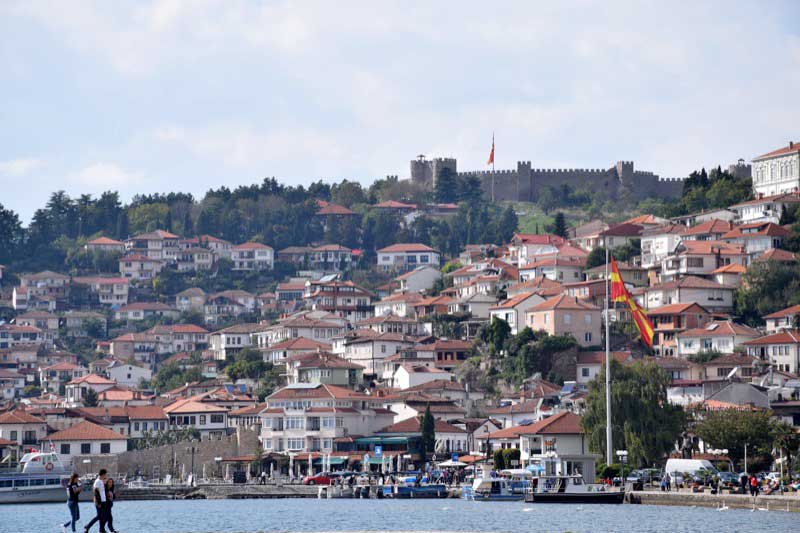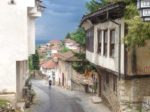Photo credit: Peter Guttman
Magnificent North Macedonia: 6 Reasons to Visit the Undiscovered Gem of the Balkans

A compact jewel of a country blue with lakes and green with forested mountains, the little landlocked republic of North Macedonia might just be one of Europe’s most intriguing and underrated travel gems. Surrounded by Greece, Albania, and Bulgaria on the Balkan Peninsula, this tiny nation has occupied a long forgotten and under-explored corner of the globe. But today it is ready to step out of the shadows of its frequently overlooked — yet historically significant — past.
Though small in size, North Macedonia encompasses a fascinating blend of ancient sites, magnificent mountain monasteries, pristine landscapes, and rich local culture. The nation’s capital city, Skopje, was around before the time of Christ, and its sole UNESCO World Heritage Site — deep blue Lake Ohrid and the culturally rich Byzantine town of Ohrid on the lakeshore — is a sublime slice of gorgeous scenery and Mediterranean style without the crowds.
The country’s three national parks are covered in waterfalls, glacial lakes, and glorious mountain peaks; and offer some of the most awe-inspiring hikes you’ll find in Europe. And as a bonus, Macedonian food is starting to gain an international reputation, as are the country’s excellent award-winning wineries.
Whether seeking vibrant art and culture or thrilling new landscapes and outdoor adventures, here are six reasons to plan your next trip to North Macedonia:
1. Skopje’s Stellar Architectural Contrasts
Skopje, the capital of North Macedonia, is a city of many cultures. Settled since Neolithic times, it’s been influenced by ancient Rome, Byzantium, the First Bulgarian Empire, and the Ottoman Turks. Today, these rich layers of history are reflected in the city’s quirky blend of old Orthodox churches, Muslim mosques, and Yugoslavian modernist buildings – revealing both Skopje’s cosmopolitan past and its forward-looking future.
You can get a sense of Skopje’s complex heritage at the Byzantine Skopje Fortress, which has guarded the city since the 6th century. Located on the highest point in the Old Town, the fortress offers an excellent vantage point from which to view the city and the mountains in the distance.

Near Skopje Fortress is the little Sveti Spas, or “Holy Savior,” Church. Originally built in the 14th century, Sveti Spas is the Old Town’s only remaining Orthodox church, and unique because of its partially submerged design (the result of an old Ottoman decree banning churches from being taller than mosques). Its gorgeous 19th century iconostasis was carved in walnut by renowned local woodcarvers.
Skopje’s Ottoman influence can be best seen in the wonderful old Turkish quarter, or Carsija. Here, the teeming bazaar — the largest in the Balkans — displays hand-loomed carpets, antique silver, spices, woven pillows, and nargileh (water pipes). Old caravanserais have been transformed into traditional restaurants and art galleries, and lively little cafes and cubbyhole shops line the streets.
(click image to view larger photo)
Much to the dismay of historians and preservationists, Skopje has been given a drastic makeover in recent years as part of a highly controversial and costly renovation project called “Skopje 2014.” Meant to give both tourism and national pride a boost, the city center has been transformed by enormous faux-neoclassical monuments, museums, fountains, and statues. Locals and tourists alike have strong feelings about the new redesign, but the end result is nevertheless an impressive, surprising sight to behold.
2. The UNESCO-Listed Oasis of Lake Ohrid
Gorgeous Lake Ohrid is the oldest and deepest lake in the Balkans, and North North Macedonia’s crowning jewel. With an age of almost five million years, it’s considered to be one of the most biodiverse lakes of its size in the world. UNESCO honored both its natural and historical importance in 1979, when it designated Ohrid a World Heritage Site, along with the lakeside town of the same name.

Many North Macedonians flock to the region’s lovely little beaches and boardwalk cafes, but Ohrid also boasts a beautiful Old Town that abounds with Mediterranean flair and ancient archaeological sites including a Greek amphitheater and a fortress. Its antiquities, red-roofed houses, and beautiful setting combine to make it a fascinating town.
Ohrid was an important religious site for hundreds of years, and its landscape is still dotted with dozens of fabulous medieval monasteries. The churches of Sveti Jovan at Kaneo and Sveti Naum offer postcard-perfect views ideal soaking up a stunning lakeside sunset. Art lovers will want to visit the Church of Sveta Bogorodica Perivlepta, whose incredible icon gallery is second only to Moscow’s famed icon collection.
(click image to view larger photo)
As you stroll the cobbled lanes of the Old Town, look out for the one-of-a-kind “Ohrid pearls,” which are made from the scales of a small fish said to exist only in Lake Ohrid. The method for making the pearls is reportedly a closely guarded secret.
3. Offbeat Art & Culture in Beautiful Bitola
Perched on a 2,000-foot plateau near Pelister National Park, the little-known town of Bitola was the former diplomatic and cultural center for the Ottoman Empire. Between the 18th and 19th centuries, almost every major European country kept a consulate here. The resulting influx of international architectural styles, mixed in with old Ottoman mosques and markets from centuries past, transformed Bitola into a sophisticated, cosmopolitan hub in its heyday.

While some of Bitola’s former glory has faded, the town has managed to preserve its elegant heritage homes, café culture, and laid-back lifestyle. You’ll see this best along buzzing Sirok Sokak Street, the main promenade at the heart of town. Lined with pretty pastel-colored buildings and packed cafes, the street is a wonderful spot to relax over a cup of coffee and watch everyday local life swirl by.
Bitola’s celebrated cultural scene has also returned to the forefront, just as it did more than a century ago. Every year the town hosts Bit Fest, a summer-long arts festival presenting a variety of concerts, art exhibits, literary readings, and comedy performances in several venues throughout town.

Bitola is also home to the renowned Manaki Brothers International Film Festival, which screens more than 200 independent foreign films, shorts, and documentaries each year. Several famous celebrities have attended the festival since it began in 1979, including Catherine Deneuve, Daryl Hannah, Isabelle Huppert, and Juliette Binoche.
4. Astounding Ancient Ruins
Though no bigger than the size of Vermont, North Macedonia holds a veritable treasure trove of ancient archaeological sites. The country boasts some of Europe’s best preserved Greek and Roman ruins, not to mention the remains of Neolithic villages, historic fortresses, and one of the world’s oldest observatories — Kokino, often called the “Stonehenge of North Macedonia” and currently on UNESCO’s tentative World Heritage list.

Among the country’s collection of historic highlights is Stobi, considered by many to be the most significant archaeological site in North Macedonia. Originally a crucial commercial hub belonging to the ancient Paionian kingdom, Stobi was founded at the point where the Via Egnatia, the Via Axia, and the Via Diagonale trade routes met. Remains include a Roman amphitheater, several big churches with beautiful examples of mosaics and stonework, and a synagogue dating between the 3rd and 4th centuries BC.

Another of North Macedonia’s most important sites is the old Hellenic city of Heraclea Lyncestis, founded by Philip II of Macedon in the middle of the 4th century BC. Conquered by Romans in the 2nd century BC, Heraclea was an important stop on the Via Egnatia, and a bustling commercial center until its eventual demise in the 6th century. Several Roman monuments remain here, including baths and an amphitheater. Don’t miss the beautiful Byzantine basilicas, all richly decorated with detailed mosaics of local plants and animals.
5. Endless Outdoor Adventures
With two of Europe’s oldest lakes, three national parks, and more than 50 mountains above 6,500 feet, North Macedonia is an adventure-lover’s playground. Still largely under the tourist radar, the country’s lush landscape is both remarkably pristine and blissfully quiet; and its diverse topography offers fantastic opportunities for hiking, biking, horseback-riding, hot-air ballooning, and more.

Pelister is North Macedonia’s smallest but oldest national park. Located in the southwestern region of the country near the border with Greece, Pelister offers beautiful alpine forests, waterfalls, and some of North Macedonia’s most accessible hiking and biking trails. The most popular trek takes you up to 8,500-foot Mt. Pelister, its summit crowned with two gorgeous glacial lakes.

Mavrovo is the largest national park in North Macedonia, and home to the country’s highest peaks including Mt. Korab, towering at over 9,000 feet. The park boasts one of the most challenging stretches of the Via Dinarica, a 1,200-mile cross-country trail that traverses much of the Balkan Peninsula. Aside from its awe-inspiring scenery and wildlife, Mavrovo also contains a number of atmospheric traditional villages that belong to North Macedonia’s ethnic minorities.

Galicnik straddles an 88-square-mile stretch of land between Lake Ohrid and Lake Prespa, and harbors some of the most diverse native flora and fauna of North Macedonia’s national parks. With breathtaking mountain views in almost every direction, Galicnik is considered one of the best and most affordable destinations for paragliding.

6. Fabulous Food & Wine
Combining the simple, farm-fresh flavors of Mediterranean cuisine with centuries of Ottoman influence, North Macedonian cuisine is rich, hearty, and complex. Though the country has modernized somewhat over the last century, many locals continue to rely heavily on small-scale agriculture and homemade products, using bountiful organic produce as the basis for their culinary creations.
Feasting is ingrained in North Macedonian culture, so expect most meals to be multi-course affairs. Lunches and dinners typically start with small bites called meze — appetizer-sized dishes that can include grilled vegetable dips and spreads, salads, tangy homemade cheeses, or treats such as burek (little baked pies stuffed with spinach or cheese.) The main course might be home-style baked beans, slow-roasted lamb, pastrmajlija (the North Macedonian meat-and-pepper stuffed equivalent of pizza,) or stuffed vegetables.
(click image to view larger photo)
North Macedonia’s savory, rich dishes are perfectly complemented by the country’s full-bodied wines, which are some of the best you’ll find in the Balkans. Wines have been produced here since the time of Philip II, and are unique because they are made with very little — if any — sugars or sulfite preservatives.
Today nearly every village family continues the tradition with their own homegrown versions, but you’ll find some of the best ones in Tikves – the fertile, grape-growing heartland of North Macedonia. Carve out some time to visit the region’s renowned local vineyards, and be sure to stock up on any favorite bottles you might happen to sample. Macedonian wines are notoriously difficult to find outside of the country.
Travel with MIR to North Macedonia
MIR has over three decades of Balkans travel experience with on-the-ground support, guides, and tour managers that clients rave about. Our full service, dedication, commitment to quality, and destination expertise have twice earned us a place on National Geographic Adventure’s list of “Best Adventure Travel Companies on Earth.”
Here are five ways to explore North Macedonia with MIR:
- Balkan Odyssey: Crossroads of Cultures – small group tour. This overland journey ties together seven of the wildly divergent Balkan countries: Albania, Bosnia and Herzegovina, Croatia, Kosovo, North Macedonia, Montenegro, and Serbia.
- Venice to Istanbul by Private Train – an 11-day rail journey through 9 countries.
- Essential Balkans – a private, independent trip, traveling on your own dates using our itinerary of the seven Balkan countries.
- Essential Albania, Macedonia & Kosovo – a 10-day flexible independent itinerary, weaving together the art, landscapes, and cultures of Albania, North Macedonia, and Kosovo.
- Your handcrafted, private itinerary – customized to your dates, interests, and pace. Travel wherever, however, and with whomever you like relying on our expert assistance.

























